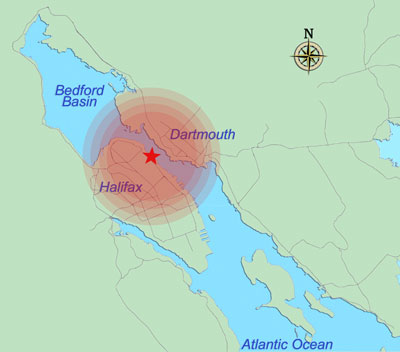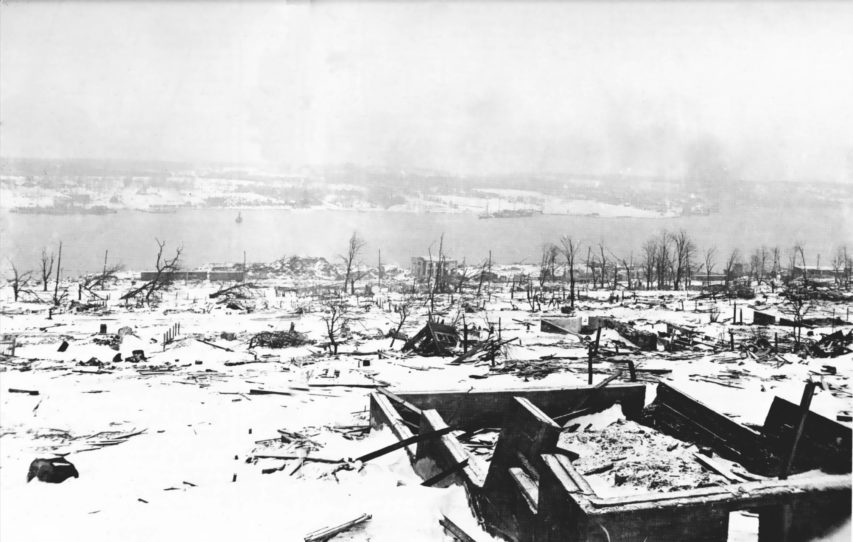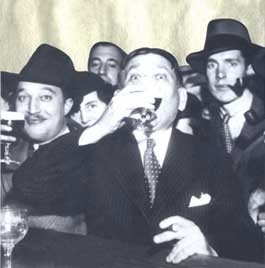The Great War
Published on 4 Dec 2017Get Immanuel’s book about the Alpenkorps in English: https://www.zeit-lupen.de/alpinecorps
When World War 1 broke out, the German Army didn’t really have troops specialised in mountain warfare. But by 1915, they brought together the first parts of the Alpenkorps. To train them, the troops were sent – in secrecy – to the new Italian front to learn from their Austrian counterparts. From May to October 1915 the Alpenkorps was forged in the Dolomites on the peaks with names like Lagazuoi, Col di Lana or Marmolata.
December 5, 2017
Origins Of The German Alpenkorps I THE GREAT WAR On The Road
Happy Repeal Day!
Eighty-four years ago today, the US repealed Prohibition. Baltimore’s own H.L. Mencken was among the first to publicly celebrate the demise of the hated legislation:
Reason‘s Baylen Linnekin celebrates the federal anniversary, but points out that devolving powers to the various states hasn’t been quite a libertarian panacea:
[December 5th] will mark the 84th anniversary of the ratification of the Twenty-First Amendment, which repealed alcohol Prohibition. The repeal of Prohibition is worth celebrating, even if the amendment was (and remains) a deeply flawed vehicle.
The chief flaw with the Amendment is, as I wrote earlier this year, that it “simply shifted much of the power to prohibit and incessantly regulate alcohol from the federal government to the states.”
States have truly made the most of their teetotalitarian authority for decades, to the detriment of both alcohol producers and—much more so—consumers.
Much of the negative impacts of states’ approach to alcohol regulation can be tied to what’s known as the three-tier system, a Prohibition relic under which states generally prohibit direct alcohol sales from a brewer, vintner, or distiller to a consumer. The three-tier system mandates these alcohol producers first sell to a distributor or retailer — a mandatory middleman — who can then sell to actual drinkers.
Laws that require this approach create a host of problems, including, for one, that they drive up consumer costs dramatically and needlessly. States’ plenary control over alcohol has been controversial for decades, as this 1987 article in the Journal of Public Health Policy makes clear, noting that “the idea of a government monopoly of a consumer product seems odd and even bizarre[.]”
Great arguments in favor of scrapping the dreaded three-tier system are often countered by those who claim doing so will bring about the end of days, or worse.
Reposted from 2013:
ReasonTV
Published on 5 Dec 2012In honor of Repeal Day, which celebrates the end of America’s “noble experiment” in banning alcoholic beverages, Reason TV is happy to introduce you to George Cassiday, a man whose life and work should be taught to every schoolkid — and to every member of Congress hell-bent on legislating the nation’s morals.
From 1920 through 1930 — the thick of the Prohibition era — Cassiday supplied illegal liquor throughout the halls of Congress. Known as “The Man in the Green Hat,” Cassiday was the Capitol’s highest-profile bootlegger, with a client list that included senior members of the Republican and Democratic Parties. How instrumental was he to the D.C. power elite? He even had his own office in the House and Senate office buildings.
Cassiday gave up the liquor trade after his arrest in 1930, but gained notoriety by penning a series of front-page articles for The Washington Post about his days as Congress’ top bottle man.
Though he never named names, Cassiday’s stories detailed every aspect of his former business — and the depths of hypocrisy in Washington. By his own estimation, “four out of five senators and congressmen consume liquor either at their offices or their homes.” Appearing days before the 1930 mid-term elections, Cassiday’s revelations caused a national stir and helped sweep pro-Prohibitionist — and ostensibly tee-totaling — congressmen and senators out of power.
Today, with the rise of cocktail culture and prohibition-vogue in full swing, Cassiday’s life and legacy are being re-discovered. Through books such as Garrett Peck’s Prohibition in Washington, D.C.: How Dry We Weren’t to New Columbia Distillery’s Green Hat Gin, the remarkable story of George Cassiday — “The Man in the Green Hat” — is again being told.
Reason TV spoke with Cassiday’s son, Fred, author Garrett Peck, and New Columbia Distillery’s John Uselton to discuss George Cassiday and the end of Prohibition.
The Halifax explosion of 6 December, 1917
It’s been called one of the largest man-made non-nuclear explosions and it destroyed large parts of the City of Halifax, when the SS Mont Blanc ran aground and exploded following a collision in the Narrows between Halifax and Dartmouth with the chartered Belgian Relief ship SS Imo. Nearly two thousand people were killed and thousands more injured in the blast.

A view of the Halifax waterfront shortly after the explosion on the morning of 6 December, 1917
Image via Wikimedia.
The Mont Blanc was built in 1899 in Middlesbrough, England, and at the time of the explosion was owned by Cie Generale Transatlantique with a St. Nazaire registration. As far as I’m aware there is only one photo of the ship and it shows the stern of the vessel when she was sailing under a Marseilles registration:
Mont Blanc had left New York harbour with a full load of flammable and explosive cargo (including TNT, picric acid, benzol aviation fuel additive, and guncotton) intended for the battlefront in western Europe on the first, and just missed being allowed inside the anti-submarine netting protecting the entrance to the harbour on the evening of the fifth, being forced to wait outside until morning. As soon as the harbour guard allowed passage, the Mont Blanc followed another freighter (believed to be the SS Clara, but identified only as “the green American tramp steamer” in the inquiry) through the barrier and approached the narrows.
As the Mont Blanc made her way up toward the Bedford Basin, the Imo started in the opposite direction headed toward the harbour mouth. The Clara was sailing up the Halifax side of the channel, contrary to harbour rules, so the Imo had to swing over toward the Dartmouth side to avoid the Clara, and then further to the wrong side of the Narrows to avoid the Stella Maris, a tug moving barges around the harbour. In the low visibility, Imo‘s captain and pilot were unaware that another ship was following the Clara so closely and on the correct side of the channel.
According to the accepted “rules of the road”, in this situation the first ship to signal has the right of way and the other ship is expected to defer to the movement of the first ship. Mont Blanc‘s pilot had the ship’s whistle blown once, to indicate their priority, but the Imo replied with two whistles indicating that they did not intend to allow Mont Blanc‘s right of way. At first sighting, the two ships were already within a mile of one another and within the narrowest point of the harbour, which restricted the ability of the Mont Blanc to manouvre. The captain ordered the engines stopped and to steer closer to the Dartmouth side of the channel (with his delicate and explosive cargo, he didn’t want to run the risk of going aground).
Imo was carrying no cargo on this portion of her journey, which meant the propellers were partially out of the water, making the ship much less handy to steer. As the two ships approached, with the ships on approximately parallel courses, the Imo‘s captain ordered the engines to reverse, which caused Imo to swing to starboard (right) and impact the starboard side of the Mont Blanc at 8:45am. The collision did not do fatal structural damage to either ship, but it broke open some of the benzol containers on the deck and the spilled liquid ran down the side of the Mont Blanc, producing a flammable vapour.

The immediate impact of the explosion covered 325 acres, and windows were broken more than 50 miles away.
Image from http://www.halifaxexplosion.org/explosion2.html
As the Imo‘s engines began to pull the ship back, friction between the two hulls ignited the benzol fumes, which then spread the fire up the hull and onto the foredeck, preventing any effective fire-fighting on the part of the Mont Blanc‘s crew. With no hope of preventing an explosion, the crew abandoned ship and rowed away from the stricken Mont Blanc, which carried on across the channel and eventually ran aground on the Halifax side near Pier 6 at the foot of Richmond Street. At 9:04am, the main cargo exploded, ripping the ship apart and sending chunks of the hull out over the buildings at the waterfront, some landing up to 3.5 miles away from the site of the blast.

This photo was taken two days after the explosion, looking across the Narrows toward the wreck of the SS Imo, aground on the Dartmouth shore.
Image via Wikimedia.
The Wikipedia entry tells of the moment of the explosion:
The ship was completely blown apart and a powerful blast wave radiated away from the explosion at more than 1,000 metres (3,300 ft) per second. Temperatures of 5,000 °C (9,030 °F) and pressures of thousands of atmospheres accompanied the moment of detonation at the centre of the explosion. White-hot shards of iron fell down upon Halifax and Dartmouth. Mont Blanc‘s forward 90 mm gun, its barrel melted away, landed approximately 5.6 kilometres (3.5 mi) north of the explosion site near Albro Lake in Dartmouth, while the shank of her anchor, weighing half a ton, landed 3.2 kilometres (2.0 mi) south at Armdale.
A cloud of white smoke rose to over 3,600 metres (11,800 ft). The shock wave from the blast travelled through the earth at nearly 23 times the speed of sound and was felt as far away as Cape Breton (207 kilometres or 129 miles) and Prince Edward Island (180 kilometres or 110 miles). An area of over 160 hectares (400 acres) was completely destroyed by the explosion, while the harbour floor was momentarily exposed by the volume of water that vaporized. A tsunami was formed by water surging in to fill the void; it rose as high as 18 metres (60 ft) above the high-water mark on the Halifax side of the harbour. Imo was carried onto the shore at Dartmouth by the tsunami. The blast killed all but one on the whaler, everyone on the pinnace and 21 of the 26 men on Stella Maris; she ended up on the Dartmouth shore, severely damaged. The captain’s son, First Mate Walter Brannen, who had been thrown into the hold by the blast, survived, as did four others. All but one of the Mont Blanc crew members survived.
Over 1,600 people were killed instantly and 9,000 were injured, more than 300 of whom later died. Every building within a 2.6-kilometre (1.6 mi) radius, over 12,000 in total, was destroyed or badly damaged. Hundreds of people who had been watching the fire from their homes were blinded when the blast wave shattered the windows in front of them. Stoves and lamps overturned by the force of the blast sparked fires throughout Halifax, particularly in the North End, where entire city blocks were caught up in the inferno, trapping residents inside their houses. Firefighter Billy Wells, who was thrown away from the explosion and had his clothes torn from his body, described the devastation survivors faced: “The sight was awful, with people hanging out of windows dead. Some with their heads missing, and some thrown onto the overhead telegraph wires.” He was the only member of the eight-man crew of the fire engine “Patricia” to survive.
Intercolonial Railway dispatcher Vince Coleman is credited with saving some three hundred passengers of an inbound Saint John train, by going back to the telegraph office and ordering the train to stop outside the likely blast zone: “Hold up the train. Ammunition ship afire in harbor making for Pier 6 and will explode. Guess this will be my last message. Good-bye boys.” The train was only slightly damaged and there were no fatalities onboard. Coleman died at his post when the ship exploded.
The earliest rescue efforts were mounted by the crews of British, Canadian, and American naval ships in port, and two US Navy ships that arrived later in the day. Many wounded were brought aboard the ships and treated there: the explosion having taken down all the electric power lines in the area, these were the best-lighted-and-heated places to take the injured until emergency power lines could be set up onshore.
Later in the day, a small fire near the magazine of Wellington Barracks caused a panic about a second explosion which hampered early rescue attempts adjacent to the blast area. Rescue trains were dispatched from many communities in the Maritimes and New England, including a major relief effort from Boston. A severe winter storm struck Halifax the next day, causing further delays in locating and assisting wounded and injured Haligonians. Sixteen inches of snow blocked several railway lines, and caused greater distress among the survivors, and knocking out the telegraph lines that in many cases had only just been re-connected after the blast.
For further reading on the explosion, the rescue efforts, and the aftermath, I can recommend Laura M. Mac Donald’s Curse of the Narrows, which recounts a great many individual stories of the people of Halifax and Dartmouth who lived through the disaster.
Update, 6 December: Rick Tessner sent me a link to this video which does a good job of explaining what happened to cause the explosion.
Sixty Symbols
Published on Dec 4, 2017Sixty Symbols regular Dr Meghan Gray on an infamous event that occurred in her home town – the Halifax Explosion of December 6, 1917.
MORE DETAILS
Maritime Museum of the Atlantic: https://maritimemuseum.novascotia.ca/…
Nova Scotia archives stuff: https://novascotia.ca/news/smr/2009-1…
CBC: http://newsinteractives.cbc.ca/halifa…While not a typical video for us, Dr Gray is a Sixty Symbols stalwart and really wanted to share the story of this explosion which is an event of great interest to her home town of Halifax — and an event with a pretty significant science component.
History of the Gun Part-7: Rifling
RugerFirearms
Published on 10 Feb 2010The “History of the Gun” online video series produced by Ruger is a unique look at the progression of firearms technology throughout the years, hosted by Senior Editor of Guns & Ammo Garry James. Part 7 examines Rifling.
QotD: Why mid-20th century Americans ate what they did – 4
The foods of today’s lower middle class are the foods of yesterday’s tycoons. Before the 1890s, gelatin was a food that only rich people could regularly have. It had to be laboriously made from irish moss, or calf’s foot jelly (a disgusting process), or primitive gelatin products that were hard to use. The invention of modern powdered gelatin made these things not merely easy, but also cheap. Around 1900, people were suddenly given the tools to make luxury foods. As with modern Americans sticking a flat panel television in every room, they went a bit wild. As they did again when refrigerators made frozen delights possible. As they did with jarred mayonnaise, canned pineapple, and every other luxury item that moved down-market.
Of course, they still didn’t have a trained hired cook at home, so the versions that made their way into average homes were not as good as the versions that had been served at J.P. Morgan’s table in 1890. But it was still exciting to be able to have a tomato aspic for lunch, in the same way modern foodies would be excited if they found a way to pull together Nobu’s menu in a few minutes, for a few cents a serving.
Over time, the ubiquity of these foods made them déclassé. Just as rich people stopped installing wall-to-wall carpeting when it became a standard option in tract homes, they stopped eating so many jello molds and mayonnaise salads when they became the mainstay of every church potluck and school cafeteria. That’s why eating those items now has a strong class connotation.
Megan McArdle, “Friday Food Post: The Economics Behind Grandma’s Tuna Casseroles”, Bloomberg View, 2015-10-30.





